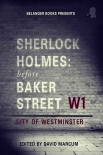Sherlock Holmes: Before Baker Street, David Marcum [reading books for 4 year olds .txt] 📗

- Author: David Marcum
Book online «Sherlock Holmes: Before Baker Street, David Marcum [reading books for 4 year olds .txt] 📗». Author David Marcum
“It was a late afternoon in early October when there was a knock at my door. I opened to find a man in his thirties, well dressed, and trying to catch his breath from the steep climb to my top-floor rooms. I had observed him on several occasions since his arrival earlier in the week. He was what I considered to be a short-timer, as there had been no indication that he had moved in with more than what would be needed for a few days in the capital. No matter what time I had arrived or departed during the recent days, he had been in the parlour, staring at the painting that you and I were admiring just a quarter-hour ago. I had been curious about the object of his fascination – you have seen that it isn’t the Mona Lisa, after all – but it had been none of my business.
“‘Mr. Holmes?’ he wheezed. Clearly, climbing six flights of stairs was not part of his normal routine.
“I observed that he was left-handed, smoked Trichinopoly cigars, had attended Corpus Christi College at Cambridge, hunted with a bow for sport, had written letters both the previous evening and again that morning, as shown by the overlapping ink spots on his fingers. He suffered from digestive complaints, was unmarried but with sweetheart, had a slightly built-up left shoe manufactured by Tundell’s off the Strand, and that he was from north of London. In his hand, he carried a rolled canvas.
“I nodded to indicate that he had found the right man and motioned for him to enter. He dropped into my sole visitor’s chair near the front window, standing the painting, for it was unrolled just enough to see that that was what it was, beside him.”
“‘Early 1800’s, I’d venture,’ gesturing toward it.
He glanced toward it in surprise. ‘Why yes? How did you know?’
“‘I’ve made a study of both canvas and paints. I can tell from the portion of the sky revealed there that it is from that general period. Does it relate to the painting that you have been pondering so steadfastly downstairs for the past week?”
He looked at me as if I were some sort of necromancer and nodded. Then he bent and unrolled it upon the floor between us. The setting sun hadn’t quite yet fallen behind the Museum, and there was still enough light to pick out the details. I slid from my chair to the floor, kneeling to lean closer. It was clearly by the same painter as the one downstairs in the parlour, and in many respects, it was the same scene, though perhaps the better of the two. This painting did not have the dingy yellow-browns of the other. Rather, it was brighter, with the clear blue skies giving it a more fresh feeling. However, the man on the horse, the boy, and the cows were practically identical. Yet the background was different – this was a bluer sky, as I said, and instead of a distant dark grove of trees on one side and an old house on the other, there was a manor house in the distance, more centered behind the horseman, as if he had been interrupted by the boy while on his way there. Instead of a hat in the boy’s hand, the rider was curiously handing him a knife. Ignoring the safe way to do such a thing, the man on the horse had retained a normal grip on the handle, leaving the boy to reach for the blade. In the foreground was a stream with various rocks piled along its banks, looking as if they had been cut and arranged there long ago by masons to prevent the bank from eroding.
“‘Interesting,’ I muttered, then looked up. ‘I suppose there is some reason that there are two of these paintings. Perhaps a message?’ He nodded, and when I added, ‘A treasure hunt?’ he clapped his hands together.
“‘That’s it exactly!’ he cried. ‘They told me that you were some sort of detective, and that you know things that others do not. I can see I’ve come to the right place!’
“I had, in truth, seen a few things already, but I needed to know more. Returning to my seat, I said, ‘What is the history of these paintings?’
“He nodded, as if that were a fair question, and began. ‘My name,’ he said, ‘is Edward Cavenham, and my people have lived near Bishop’s Stortford since beyond memory.’ He pointed toward the painting on the floor. ‘That’s the family house there in the background. It doesn’t look much different now than when that was painted – ‘
“‘The year being – ?’
“‘Early 1800’s. That fits with the story I’m going to relate, as we have learned from letters handed down within our family. In 1810, my grandfather, Richard Cavenham, was serving in the Royal Navy, against the wishes of his father, Lloyd. He was at the battle of Grand Port, when the French forced the British surrender following the failed attempt to blockade the Isle de France. He was taken prisoner, but because he was an officer, he was treated with dignity, even being entertained in some of the finer French homes.
“‘While there, he became immediately enamored with his host’s daughter, Lisette Duvelle. Within a few weeks, they had wed. It is not recorded what Lisette’s father thought, although there seems to have been no objection, but the upshot was that my father’s release was negotiated, and he returned with his new bride to the family home in Hertfordshire, hard





Comments (0)